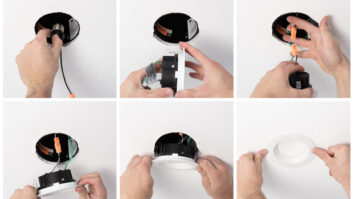Retrofit definitely separates the men from the boys in the custom installation business. Anyone thats done it for awhile will attest to the fact that it requires and/or builds confidence, strength, patience, and character. These are all admirable qualities for any profession.
To encourage you, this article will pass along some hard learned tips and recommendations to get you started in the retrofit world.
There is certainly some science to retrofitting (planning steps, knowing construction techniques) but mainly its an art, still learned primarily by apprenticeship. To be successful you need to be good at both the science and the art. Ill try to cover a little of both by dividing it into the three Ps: Planning (including understanding construction techniques), Practice (including tools and training), and Patience.
Do the Planning
Planning on any job is essential, but in retrofit, it means the difference between making money and making a mess. Never start a retrofit job until you know the following about the house youre about to cut into.
- The general house framing style (see above)
- Any remodeling that has been done in the past
- Where all attic spaces are and how to get to them
- Where all basement/crawl spaces are and how to get to them
- What walls you can access from the attic/basement/crawl space
- The material used on all interior walls and ceiling
- (lath/blaster, cement board, sheetrock)
- Which walls contain insulation and what type
- If two story, what walls are common between floors (make sure)
- Where the water cut-off is (that you personally tested)
- Where the gas cut-off is
- Where the major plumping fixtures are where the pipes go
- If radiator heat, where the pipes go
- If forced air heating/cooling, where the ducting is run.
I could go on, but these are the major items. Finding out all of them requires time, so spend it. Most important, however, is figuring out where every cable will go before you start the job. Every hour that you spend in planning will save you more than four hours on the job. Guaranteed.
Learning Construction Techniques
You definitely need to know how the houses in your area are built. If you live in the Northeast and Midwest, then youre lucky because most of the homes there are built using balloon construction. This style features wall studs that run from the foundation all the way to the roof rafters. All floor joists are nailed directly to the wall studs. Its great. Take the job.
Everything built after the 1950s is probably whats called platform construction. Each floor is built as a unit or platform and either sits on the foundation or on the walls of the floor below. Nothing lines up. Take the job only after you have studied the situation more carefully.
After youve been working in an area for awhile, youll begin to figure out who built what and when, and it will be a lot easier to plan the job.
Get the Right Tools
I learned retrofit skills when I was in high school working for an installer at the local high-end stereo equipment store. All we really had was the usual electricians fish tape, coat hangers, his wifes mirrors, a flashlight, string, electrical tape, and typical hand tools. Thankfully, those days are over. We now have a vast assortment of specialty retrofit tools to tackle the most demanding jobs. In fact, there are so many tools, that they tend to confuse the new installer.
What tools you use is mainly a matter of personal preference.
Stick with a basic set of tools youre comfortable with and know how to use (because you practiced). If you have too many tools, youll waste time trying to use them.
- A ball chain and magnetic retriever
- A router, such as a Roto-zip
- A wall-eye half periscope device for seeing up/down a wall
The two best sources of tools are BES Manufacturing (www.fiberfish.com) and Labor Saving Devices (www.lsdinc.com). They both sell through distributors, but not all distributors sell all their tools so shop around.
Getting the Training
The tools are useless unless you know how to use them, and most people dont. You either need to attend a class, watch a training DVD, or apprentice with someone who knows the skill. Apprenticing is the best choice if you are sure that the person from whom you are learning actually knows which end of a push-rod to push. If theyre still using coat-hangers and electricians fish-tape, then reconsider.
There is a good selection of training DVDs available. Roy Bowling, the founder of Labor Saving Devices, made a set of DVDs that demonstrate a lot of the basic tools and retrofit techniques. Call to find out who stocks them (800.648.4714). Training Reels offers a four-hour DVD training course (with CEU credits) that covers tools and installation techniques and demonstrated actual field installations. Watch clips from the course at www.trainingdept.com/html/videos.html.
CEDIA University offers hands-on retrofit training as part of its EST100 (Basic Residential Boot Camp) course (www.cedia.org/education). My own Training Dept. Seminars feature one-day retrofit workshops several times a year at trade shows and CEDIA University, etc. Check www.trainingdept.com/html/ seminars.html for a schedule.
Practice, Practice, Practice
Retrofit is a 70 percent manual dexterity skill. It requires physical practice, preferably not on the customers house. Always practice with the tool someplace harmless first. You may even find that the tool is a waste of time.
I highly recommend two ways to practice. First, build yourself a practice wall in your shop or garage. You can build the whole thing for under $100 (or for less if you scrounge your latest new construction job site). Cover most of the walls with sheetrock and fill half the stud cavities with insulation.
If you dont have the space or want to try out two-story techniques, then find out where new houses are being built in your area and drive out on the weekend and practice on a new house in the framing stage. Ive done this at least a dozen times and no one has ever questioned my being there, even when other trades were working on the house! Ive tried out a lot of new bits this way.
If you practice one thing, learn how to properly use your drill bits. Probably the hardest skill is drilling up a wall from a single-gang outlet cut-out through the top plate. Practice this using a drill guide to position the drill near the center of the top plate with a 1/2-inch bit (both twist and auger style). Everything else is easier.
Patience
There is nothing harder than keeping your patience when you are on the job, behind schedule, and with the customer or builder breathing down your neck. If youre under 40, then its even harder. But retrofit demands patience, because without it youll waste countless hours.
There will come a time on every job when you know the cable you fished is in the damn wall but you just cant find it. Youve poked around with everything but a rake and managed to pull out all of the insulation. Every fiber of your soul is telling you to go for the Benford 10 lb. sledge. Dont do it. There is a simple reason that you cannot find the cable. Take a break, have a beer. Go work on some other part of the job. Think about it. Talk it over with your buddy. You will eventually figure it out. Its probably stuck up against the inside of the sheetrock and youve been fishing on the back of the wall (true story).
Patience is a learned skill that comes with age and experience. Write a note to yourself to start practicing on the next job.
Learn from Your Mistakes
Ive been doing retrofit for many years, and I make mistakes. Its just part of the job. Get over it. Either learn basic repair of sheetrock, plaster, molding, and so on, or find someone who can. The good news is that each mistake teaches you something. I thought the bit sounded like it was all the way through that top plate. Next time youll remember to mark the bit with masking tape at the point you need to stop drilling. It builds character.
That should be enough to keep you busy for awhile.
Grayson Evans ([email protected]) is the author of two books in the home automation field, serves as a CEDIA-certified instructor and has taught many courses at CEDIA University, CEDIA EXPO, EH Expo, and other industry events for the past 12 years.




